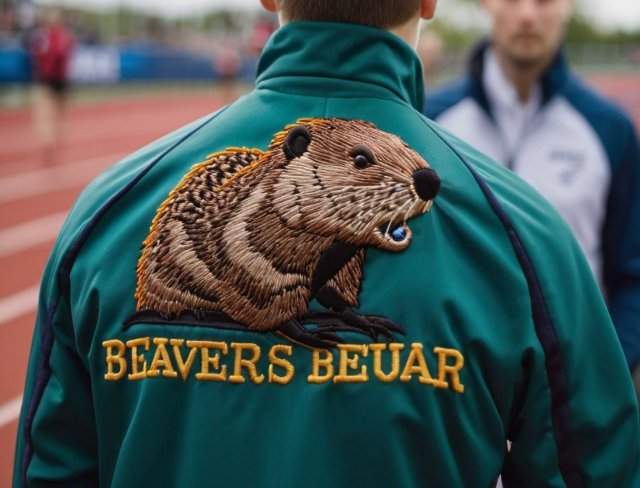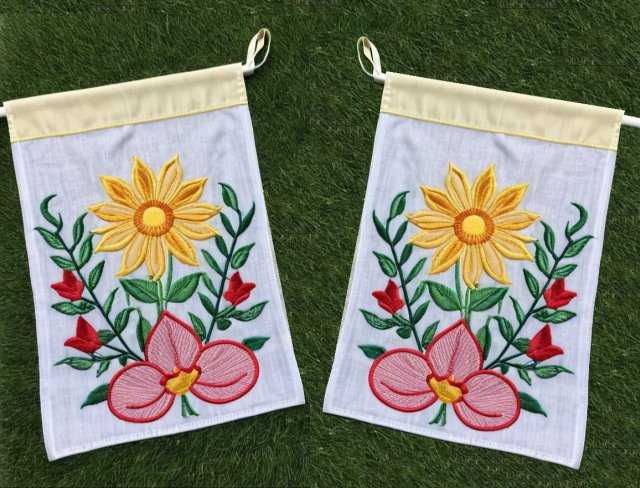Mastering Split Embroidery
Achieving Perfect Design Alignment
Introduction
Embroidery enthusiasts often encounter the challenge of working with designs that exceed the limitations of their hoop size. In such instances, splitting the design into multiple sections becomes a necessity. However, ensuring seamless alignment between these split sections can be a daunting task. This comprehensive guide delves into the intricacies of mastering split embroidery, providing a detailed roadmap for achieving perfect alignment in every stitch.
From selecting the right software and identifying strategic alignment points to hooping the fabric and completing the stitching process, each step is meticulously explored to equip embroiderers with the knowledge and techniques needed to tackle even the most complex split designs. By understanding and implementing the principles outlined in this guide, embroiderers can elevate their craft, creating stunning embroidered pieces with flawless continuity and alignment. Embark on this journey to mastery, where creativity meets precision, and every stitch tells a story of skill and artistry.
Why The Need For Split Embroidery
Split embroidery has become an essential technique for embroiderers who wish to create intricate and large-scale designs that exceed the limitations of their hoop size. Traditional embroidery hoops come in various sizes, but they often restrict the size of the design that can be stitched in a single pass. This limitation can be particularly challenging when working on detailed or expansive projects, such as large motifs, multi-panel designs, or custom artworks that require a larger stitching area than what the hoop can accommodate.
The necessity for split embroidery arises from the desire to maintain design integrity and precision without compromising on size or detail. By dividing a large design into smaller, manageable sections, embroiderers can work within the constraints of their hoop while still achieving the desired outcome. This technique allows for greater flexibility and creativity, enabling the execution of complex designs that would otherwise be impossible with a single hooping.
Moreover, split embroidery is crucial for ensuring that large designs are stitched accurately and seamlessly. When designs are split and aligned correctly, the transition between sections is virtually undetectable, resulting in a cohesive and professional-looking finished product. This technique not only enhances the visual appeal of the embroidery but also expands the possibilities for embroiderers to take on more ambitious projects, pushing the boundaries of their craft.
The ability to split and realign designs is a valuable skill for embroiderers who work on custom orders and personalized items. Clients often request specific designs or sizes that do not fit within standard hoop dimensions. Mastering split embroidery allows embroiderers to meet these demands with confidence, offering bespoke services that cater to individual preferences and requirements.
Ultimately, the need for split embroidery stems from the pursuit of excellence and innovation in the field of embroidery. It empowers embroiderers to transcend the physical limitations of their tools and create works of art that are not only larger and more detailed but also impeccably aligned and visually stunning. By embracing this technique, embroiderers can unlock new creative potentials and elevate the quality of their work, ensuring that each piece is a testament to their skill and dedication.

1. Choose the Right Software
Embroidery software plays a crucial role in the process of combining split embroidery designs with perfect alignment. Here’s why selecting the right software is essential:
Advanced Editing Capabilities: The chosen software should offer advanced editing capabilities that allow for precise manipulation of designs. This includes features such as resizing, rotating, splitting, merging, and repositioning elements within the design. Embroidery software like Embird, Wilcom, and Hatch Embroidery are known for their extensive editing tools, empowering users to customize designs with accuracy and ease.
Compatibility with Design Formats: Ensure that the software supports a wide range of design formats commonly used in the embroidery industry. This includes formats such as .pes, .dst, .exp, .hus, .vp3, and more. Compatibility with multiple formats ensures flexibility in working with designs sourced from various sources and designers.
User Friendly Interface: Opt for software with an intuitive and user friendly interface, especially if you’re new to embroidery digitizing. A well designed interface makes it easier to navigate through the software’s features, access tools, and perform editing tasks efficiently.
Stability and Reliability: Choose software that is known for its stability and reliability. This ensures a smooth and uninterrupted workflow, minimizing the risk of crashes or data loss during the editing process. Look for software that receives regular updates and support from the developer to address any issues and improve performance over time.
Community Support and Resources: Consider software that has a vibrant user community and ample online resources available. A strong community provides opportunities for learning, sharing tips and tricks, and seeking assistance when encountering challenges. Look for forums, tutorials, and user groups dedicated to the chosen software to enhance your proficiency and troubleshooting abilities.
Cost and Licensing Options: Evaluate the cost and licensing options associated with the software. Some software offers subscription based models with monthly or annual fees, while others may require a one time purchase with optional upgrades. Consider your budget and long term needs when making your decision, ensuring that the chosen software offers the best value for your investment.
By carefully considering these factors and selecting software that meets your specific requirements, you can empower yourself with the tools needed to successfully combine split embroidery designs with perfect alignment. Take the time to explore different software options, experiment with trial versions, and gather feedback from fellow embroiderers to make an informed decision that aligns with your goals and aspirations in the world of embroidery.

2. Identify Alignment Points
When preparing to split and combine embroidery designs, identifying alignment points is essential for achieving seamless alignment between the split sections. Here’s how to do it effectively:
Examine Design Structure: Begin by carefully examining the overall structure of the embroidery design. Look for distinctive features, such as corners, edges, or prominent elements, that can serve as reliable alignment points. These features should be visually distinct and easily recognizable to ensure accurate alignment during the stitching process.
Select Strategic Locations: Choose strategic locations within the design where alignment points can be placed. Aim to select points that are evenly distributed throughout the design and provide sufficient coverage across its entirety. Depending on the complexity of the design, you may need to identify multiple alignment points to ensure comprehensive alignment between the split sections.
Consider Design Elements: Take into account the specific elements and motifs present in the design when selecting alignment points. For example, if the design features intricate floral patterns, focal points such as flower centers or leaf intersections can serve as effective alignment markers. Similarly, geometric designs may have identifiable corners or vertices that lend themselves well to alignment.
Focus on Symmetry and Proportion: Pay attention to the symmetry and proportionality of the design when identifying alignment points. Symmetrical designs often have mirrored elements or repeating patterns that can aid in alignment. Additionally, consider the overall proportions of the design and ensure that alignment points are distributed proportionally across different sections to maintain balance and harmony.
Mark Alignment Points: Once alignment points have been identified, mark them directly on the fabric using fabric markers or temporary adhesive. Take care to place the marks accurately and consistently, ensuring that they align precisely with the corresponding points on the split sections of the design. These marks will serve as visual guides during the alignment process, facilitating accurate placement of the split sections on the fabric.
Verify Compatibility: Before proceeding with splitting the design, verify that the alignment points identified are compatible with the splitting process. Ensure that they are located in areas where the design can be divided without compromising its integrity or visual coherence. Make any necessary adjustments to the alignment points as needed to ensure optimal compatibility with the splitting process.
By meticulously identifying alignment points and strategically placing them within the design, embroiderers can establish a reliable framework for achieving precise alignment between split embroidery sections. This careful planning and attention to detail lay the foundation for seamless integration of the split sections and the creation of flawless embroidered masterpieces.

3. Split the Design
Splitting the oversized embroidery design into multiple files allows for more manageable stitching, especially when working with smaller hoop sizes. Follow these steps to split the design effectively:
Evaluate Design Complexity: Before splitting the design, assess its complexity and identify areas where it can be divided without compromising its integrity. Look for natural breakpoints such as empty spaces, straight lines, or distinct elements that can serve as boundaries between split sections.
Divide Design Strategically: Utilize your embroidery software’s editing tools to divide the design into logical sections while preserving the overall composition. Depending on the design’s complexity and size, you may need to split it into two or more files. Aim to divide the design in a way that minimizes disruption to intricate details and maintains visual coherence across split sections.
Align Split Points with Alignment Markers: When splitting the design, ensure that the split points align with the alignment markers identified earlier. This helps maintain continuity and alignment between the split sections when they are stitched onto the fabric. Use your software’s grid or ruler features to align split points precisely with the marked alignment points.
Check File Compatibility: Verify that each split file is compatible with your embroidery machine and software. Ensure that the file format, stitch settings, and other parameters are appropriate for your machine’s specifications. Make any necessary adjustments to ensure compatibility before proceeding with stitching.
Save Split Files Appropriately: Save each split file with clear and descriptive filenames that indicate their position within the overall design sequence. Include information such as the section number, design name, and any relevant details to facilitate organization and easy identification during the stitching process. Store the split files in a dedicated folder or location for easy access and management.
Maintain Design Integrity: Throughout the splitting process, prioritize maintaining the integrity and visual coherence of the design. Avoid splitting through critical elements or intricate details that could be disrupted by the division. Take care to preserve the overall composition and aesthetic appeal of the design across split sections.
Preview Split Sections: Before finalizing the split files, preview each section individually to ensure that they align correctly with the alignment markers and maintain consistency with the original design. Use your embroidery software’s simulation or preview feature to visualize how each section will stitch out on the fabric.
By carefully splitting the embroidery design into manageable sections while maintaining alignment with identified markers, embroiderers can streamline the stitching process and achieve flawless results across split sections. This thoughtful approach ensures that each section seamlessly integrates into the overall design, resulting in a cohesive and professionally stitched masterpiece.

4. Mark Alignment Points on Fabric
Before hooping the fabric and stitching the split embroidery sections, it’s essential to mark specific points on the fabric that will serve as reference markers for alignment. Follow these steps to mark alignment points effectively:
Select Suitable Marking Tools: Choose marking tools that are suitable for your fabric type and won’t leave permanent stains or damage. Fabric markers, water soluble pens, chalk, or temporary adhesive dots are commonly used for marking alignment points. Ensure that the chosen marking tools are easily visible against the fabric and won’t interfere with the embroidery process.
Refer to Design and Split Sections: Use the original embroidery design and the split sections as references to determine where alignment points should be marked on the fabric. Identify corresponding points on the fabric that align with key features or landmarks within the design, such as corners, edges, or distinctive elements.
Determine Placement Strategy: Strategically place alignment points on the fabric to facilitate accurate alignment between the split sections. Distribute the alignment points evenly across the fabric, ensuring that they cover the entire area where the split sections will be stitched. Consider the design’s layout and complexity when determining the placement of alignment points.
Transfer Alignment Points: Carefully transfer the identified alignment points from the design to the fabric using your chosen marking tools. Use a ruler or measuring tape to ensure that the alignment points are positioned accurately and maintain consistent spacing. Mark each alignment point with a small dot or symbol that is easily recognizable during the hooping and stitching process.
Double Check Accuracy: Double check the accuracy of the marked alignment points before proceeding with hooping the fabric and stitching. Compare the placement of the alignment points on the fabric with the corresponding points on the split sections of the design to ensure alignment consistency. Make any necessary adjustments to the marked points to correct inaccuracies or discrepancies.
Consider Hoop Placement: Take into account the placement of the embroidery hoop when marking alignment points on the fabric. Ensure that the alignment points fall within the stitching area of the hoop and won’t be obstructed during the hooping process. Position the alignment points slightly inward from the edges of the fabric to allow room for hooping without covering the marks.
Use Clear and Visible Marks: Make sure that the marked alignment points are clear, visible, and easily distinguishable against the fabric. Avoid using marking tools that may fade or smudge over time, especially if the embroidery process involves multiple stitching sessions. Reapply marks as needed to maintain their visibility throughout the stitching process.
By carefully marking alignment points on the fabric before hooping, embroiderers can establish a reliable framework for achieving precise alignment between split embroidery sections. These marked points serve as visual guides during the hooping and stitching process, ensuring that the split sections align seamlessly to create a cohesive and professionally stitched design.

5. Hoop the Fabric
Hooping the fabric securely is a critical step in preparing it for embroidery. Proper hooping ensures stability and prevents fabric shifting during stitching. Follow these steps to hoop the fabric effectively:
Select the Correct Hoop Size: Choose a hoop size that accommodates the dimensions of the embroidery design and allows sufficient space for stitching without crowding. Refer to the dimensions of the split sections and select a hoop size that comfortably fits the fabric and design within its stitching area.
Prepare the Hoop: Disassemble the embroidery hoop by separating the inner and outer rings. Ensure that both rings are clean and free from dust or debris that could transfer onto the fabric. Wipe down the hoop with a clean cloth if necessary to remove any residue.
Position the Fabric: Lay the fabric flat on a smooth, clean surface, ensuring that it is free from wrinkles or creases. Place the inner ring of the embroidery hoop on the surface beneath the fabric, with the fabric centered over the ring.
Place the Outer Ring: Carefully position the outer ring of the embroidery hoop over the fabric and inner ring, aligning it with the inner ring to form a sandwich with the fabric sandwiched between the two rings. Press down gently on the outer ring to secure it in place, ensuring that the fabric remains taut and wrinkle free.
Tighten the Screw: Gradually tighten the screw or clasp on the embroidery hoop to secure the fabric in place. Apply even pressure around the circumference of the hoop to ensure that the fabric is held firmly and evenly tensioned. Avoid over tightening the screw, as this could distort the fabric or cause it to stretch excessively.
Check Hoop Tension: Once the fabric is hooped, check the tension by gently tugging on the edges of the fabric. It should feel taut and evenly stretched across the hoop without any sagging or wrinkles. Adjust the tension as needed by loosening or tightening the screw slightly until the fabric is properly tensioned.
Verify Alignment Points: Before proceeding with stitching, verify that the marked alignment points on the fabric are visible and aligned with the inner hoop’s center. Use a ruler or measuring tape to confirm the placement of the alignment points relative to the hoop’s center, ensuring accurate alignment with the embroidery design.
Reposition if Necessary: If the fabric shifts or becomes misaligned during hooping, carefully remove the outer hoop and reposition the fabric before re tightening the screw. Take care to maintain alignment with the marked points on the fabric and ensure even tension across the entire hoop.
By following these steps and hooping the fabric properly, embroiderers can create a stable and well prepared surface for stitching split embroidery designs. A securely hooped fabric provides the foundation for achieving precise alignment and professional quality embroidery results.

6. Stitch the First Half
Once the fabric is securely hooped and aligned, it’s time to stitch the first half of the split embroidery design. Follow these steps to stitch the first half effectively:
Load the Design: Using your embroidery machine, load the first half of the split embroidery design file. Ensure that the design is positioned correctly within the machine’s embroidery area and aligned with the marked points on the fabric. Use the machine’s controls to adjust the design placement if necessary.
Thread the Machine: Thread the embroidery machine with the appropriate thread colors according to the design specifications. Ensure that the bobbin is properly wound and inserted into the machine. Perform a thread check to verify that the threads are feeding smoothly and without tangles.
Select Stitch Settings: Choose the appropriate stitch settings for the first half of the design, including stitch type, density, and speed. Refer to the design file or embroidery machine manual for recommended settings. Adjust the settings as needed to achieve the desired results, taking into account factors such as fabric type and design complexity.
Start the Stitching Process: Initiate the stitching process by pressing the start button on the embroidery machine. Monitor the stitching closely as the machine embroiders the first half of the design onto the fabric. Pay attention to the alignment of the design within the hoop and ensure that it remains centered and properly tensioned throughout the stitching process.
Pause for Trims and Color Changes: Pause the machine as needed to trim thread tails and change thread colors between color stops. Use sharp embroidery scissors to trim excess thread tails close to the fabric surface, taking care not to cut into the design. Follow the color change sequence specified in the design file to ensure accurate color placement.
Check Stitch Quality: Periodically inspect the stitching quality as the machine progresses through the design. Look for any thread breaks, tension issues, or stitching errors that may affect the final result. Address any issues promptly by rethreading the machine, adjusting tension settings, or making other necessary adjustments.
Monitor Stitching Time: Keep track of the stitching time to ensure that the machine does not run for an extended period without supervision. Embroidery machines can produce heat during prolonged operation, which may affect stitch quality or even damage the machine. Take breaks as needed and allow the machine to cool down between stitching sessions.
Complete the First Half: Allow the machine to complete the stitching of the first half of the design. Once finished, remove the fabric from the embroidery hoop and trim any excess stabilizer from the back of the design. Inspect the stitched portion for quality and alignment, ensuring that it meets your expectations before proceeding to stitch the second half.
By following these steps and closely monitoring the stitching process, embroiderers can stitch the first half of the split embroidery design with precision and confidence. A well executed first half sets the stage for seamless alignment and professional quality results in the final embroidered piece.

7. Hoop the Second Half
After stitching the first half of the split embroidery design, it’s time to prepare the fabric for stitching the second half. Follow these steps to hoop the second half effectively:
Prepare the Fabric: Start by preparing the remaining unembroidered portion of the fabric for hooping. Ensure that the fabric is clean, flat, and free from wrinkles or creases. If necessary, press the fabric lightly with an iron to remove any wrinkles and create a smooth stitching surface.
Identify Alignment Points: Refer to the marked alignment points on the fabric from the first half of the design. These points serve as reference markers for aligning the second half of the design with the stitched portion. Verify that the alignment points are still visible and accurately positioned on the fabric.
Align Fabric in Hoop: Carefully position the fabric within the embroidery hoop, aligning it with the inner hoop’s center and ensuring that the marked alignment points correspond with those on the hooped fabric from the first half. Take care to maintain even tension across the fabric and avoid distorting or stretching it during hooping.
Secure the Fabric: Once the fabric is properly aligned within the hoop, secure it in place by placing the outer hoop over the fabric and inner hoop. Press down gently on the outer hoop to hold the fabric taut and evenly tensioned. Tighten the hoop’s screw or clasp to secure the fabric in place, ensuring that it remains stable throughout the stitching process.
Verify Alignment: Double check the alignment of the second half of the fabric with the hooped fabric from the first half. Use a ruler or measuring tape to confirm that the marked alignment points on both halves align precisely and maintain consistency with the embroidery design. Make any necessary adjustments to the fabric’s position within the hoop to ensure accurate alignment.
Check Hoop Tension: Verify that the fabric is properly tensioned within the hoop by gently tugging on the edges of the fabric. It should feel taut and evenly stretched across the hoop without any sagging or wrinkles. Adjust the tension as needed by loosening or tightening the hoop’s screw until the fabric is properly tensioned.
Inspect Alignment: Before proceeding with stitching, visually inspect the alignment of the second half of the fabric within the hoop. Ensure that the fabric is centered and aligned with the marked points on the hooped fabric from the first half. Verify that there are no discrepancies or misalignments that could affect the stitching process.
By following these steps and carefully aligning and hooping the second half of the fabric, embroiderers can ensure precise alignment with the stitched portion from the first half. Proper hooping sets the stage for seamless integration of the split embroidery sections and professional quality results in the final embroidered piece.

8. Align Second Half with First
Once the second half of the fabric is hooped and prepared, it’s time to align it with the stitched portion from the first half of the design. Follow these steps to align the second half effectively:
Refer to Alignment Points: Begin by referring to the marked alignment points on both the hooped fabric from the first half and the second half of the fabric. These points serve as reference markers for aligning the two halves of the design seamlessly. Verify that the alignment points on both halves are visible and accurately positioned.
Position the Hoop: Place the hoop containing the second half of the fabric adjacent to or overlapping with the hooped fabric from the first half. Align the marked alignment points on both halves, ensuring that they match up precisely. Use the marked points as visual guides to facilitate accurate alignment between the split sections.
Utilize Machine Controls: Use the positioning controls available on your embroidery machine to fine tune the alignment of the second half with the stitched portion from the first half. Depending on your machine’s capabilities, you may be able to adjust the needle position, rotate the design, or move the hoop to achieve optimal alignment.
Verify Alignment: Take a moment to visually inspect the alignment of the second half with the stitched portion from the first half. Ensure that the design elements, outlines, and motifs align seamlessly across the split sections. Check for any discrepancies or misalignments that may affect the final stitched result.
Make Adjustments as Needed: If necessary, make adjustments to the alignment of the second half with the first half to ensure perfect alignment. Use the machine controls to fine tune the positioning of the design, making small adjustments as needed to correct any misalignments or inconsistencies. Take your time to achieve precise alignment before proceeding with stitching.
Test Stitch Alignment: Before proceeding with the full stitching of the second half, conduct a test stitch to verify alignment between the split sections. Use scrap fabric or a test piece to stitch out a small portion of the design and check for alignment accuracy. Make any necessary adjustments based on the test stitch results before stitching the full design onto the hooped fabric.
Confirm Alignment Continuity: Once satisfied with the alignment, confirm that the alignment points on both halves of the fabric remain matched up throughout the stitching process. Monitor the stitching closely as the machine embroiders the second half of the design, ensuring that alignment continuity is maintained from start to finish.
By following these steps and carefully aligning the second half of the split embroidery design with the first half, embroiderers can ensure seamless integration and continuity in the final stitched piece. Attention to detail and precision in alignment result in professional quality embroidery with flawless continuity across split sections.

9. Test Stitch Alignment
Before committing to stitching the second half of the design onto the fabric, it’s crucial to conduct a test stitch to verify alignment accuracy. Follow these steps to test stitch alignment effectively:
Prepare Test Fabric: Prepare a piece of scrap fabric or a test piece similar to the fabric used for the main embroidery project. Ensure that the test fabric is stabilized and hooped securely to mimic the conditions of the actual stitching process.
Load Second Half Design: Using your embroidery machine, load the second half of the split embroidery design file. Position the design within the embroidery area of the test fabric, ensuring that it aligns with the marked alignment points on the fabric.
Conduct Test Stitch: Initiate a test stitch of the second half of the design on the test fabric. Use the machine’s controls to start the stitching process, closely monitoring the alignment of the design as it progresses. Pay attention to how the design lines up with the marked alignment points and the stitched portion from the first half.
Inspect Stitch Quality: Once the test stitch is complete, inspect the stitching quality and alignment accuracy. Examine the alignment of the design elements, outlines, and motifs with the marked alignment points and the stitched portion from the first half. Look for any discrepancies or misalignments that may indicate issues with the alignment.
Make Adjustments as Needed: If the test stitch reveals alignment issues or discrepancies, make the necessary adjustments to correct them. Use the machine’s positioning controls to fine tune the alignment of the design with the marked points on the fabric. Make small adjustments as needed to ensure perfect alignment between split sections.
Repeat Test Stitch if Necessary: If adjustments are made, repeat the test stitch on the test fabric to verify that the alignment issues have been resolved. Conduct additional test stitches as needed until you are satisfied with the alignment accuracy and stitching quality.
Confirm Readiness for Full Stitching: Once alignment is verified and any issues are addressed, confirm that the test stitch results meet your expectations for alignment accuracy and stitching quality. Ensure that alignment continuity is maintained from the first half to the second half of the design.
Proceed with Full Stitching: With alignment confirmed and any issues resolved, proceed with stitching the second half of the design onto the hooped fabric. Monitor the stitching closely to ensure that alignment continuity is maintained throughout the stitching process.
By conducting a test stitch to verify alignment accuracy, embroiderers can identify and address any issues before proceeding with the full stitching of the second half. This proactive approach ensures that alignment is precise, resulting in professional quality embroidery with flawless continuity across split sections.

10. Complete Stitching
After conducting the test stitch and verifying alignment accuracy, it’s time to proceed with stitching the second half of the split embroidery design onto the fabric. Follow these steps to complete the stitching process effectively:
Load Second Half Design: Ensure that the second half of the split embroidery design file is loaded onto your embroidery machine. Position the design within the embroidery area of the hooped fabric, aligning it with the marked alignment points and the stitched portion from the first half.
Double Check Alignment: Before initiating the stitching process, double check the alignment of the second half of the design with the first half and the marked alignment points on the fabric. Use the machine’s positioning controls to fine tune the alignment if necessary, ensuring perfect alignment between split sections.
Start the Stitching Process: Once alignment is confirmed, initiate the stitching process by pressing the start button on the embroidery machine. Monitor the stitching closely as the machine embroiders the second half of the design onto the fabric. Pay attention to the alignment of the design within the hoop and ensure that it remains centered and properly tensioned throughout the stitching process.
Pause for Trims and Color Changes: Pause the machine as needed to trim thread tails and change thread colors between color stops. Use sharp embroidery scissors to trim excess thread tails close to the fabric surface, taking care not to cut into the design. Follow the color change sequence specified in the design file to ensure accurate color placement.
Inspect Stitching Quality: Periodically inspect the stitching quality as the machine progresses through the second half of the design. Look for any thread breaks, tension issues, or stitching errors that may affect the final result. Address any issues promptly by rethreading the machine, adjusting tension settings, or making other necessary adjustments.
Monitor Stitching Time: Keep track of the stitching time to ensure that the machine does not run for an extended period without supervision. Embroidery machines can produce heat during prolonged operation, which may affect stitch quality or even damage the machine. Take breaks as needed and allow the machine to cool down between stitching sessions.
Complete the Stitching: Allow the machine to complete the stitching of the second half of the design. Once finished, remove the fabric from the embroidery hoop and trim any excess stabilizer from the back of the design. Inspect the stitched portion for quality and alignment, ensuring that it meets your expectations.
Finalize the Embroidered Piece: With both halves of the split embroidery design stitched onto the fabric, the final step is to finalize the embroidered piece. Trim any remaining thread tails, remove any excess stabilizer, and press the embroidered fabric gently with an iron to remove any wrinkles.
By completing the stitching process for the second half of the split embroidery design with care and attention to detail, embroiderers can achieve a professional quality result with flawless alignment and continuity across split sections. This meticulous approach ensures that the final embroidered piece showcases the beauty and precision of the combined split designs.

Conclusion
Mastering the art of combining split embroidery designs to achieve perfect alignment is a process that requires attention to detail, precision, and a thorough understanding of the techniques involved. By following the comprehensive steps outlined in this guide, embroiderers can navigate each stage of the process with confidence and achieve professional quality results.
From choosing the right software for editing and splitting designs to meticulously marking alignment points on fabric, hooping, aligning, and completing the stitching process, each step plays a crucial role in ensuring seamless integration of split sections. By carefully planning and executing each stage, embroiderers can overcome the challenges posed by oversized designs and limited hoop sizes, ultimately creating stunning embroidered masterpieces with flawless continuity and alignment.
Through practice, patience, and a commitment to excellence, embroiderers can hone their skills in split embroidery and unlock endless creative possibilities. Whether working on intricate designs or large scale projects, the techniques and principles outlined in this guide serve as a valuable foundation for achieving perfect alignment and producing embroidery that captivates and inspires.
Embark on your journey to mastering split embroidery with confidence, armed with the knowledge and skills to bring your creative vision to life with precision and finesse. With dedication and perseverance, the art of combining split designs will become second nature, empowering you to create breathtaking embroidered works of art that showcase your unique talent and craftsmanship.
Now that you have read through this article, feel free to SHOP for products we have created. If you are looking for something special which isn’t in our store, feel free to contact us.










